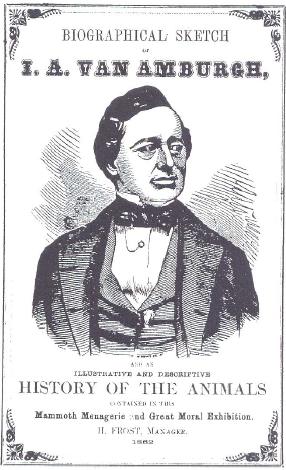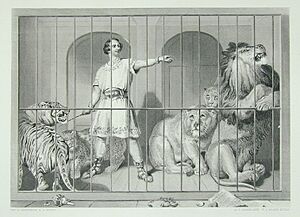Isaac A. Van Amburgh facts for kids
Isaac A. Van Amburgh (1808–1865) was an American animal trainer. He created the first trained wild animal act in modern times. His shows helped combine menageries (animal collections) with circuses. This made circuses start using animal acts, horse riders, and clowns. Over time, circuses and menageries became very similar.
Isaac started as a cage cleaner at the Zoological Institute of New York. He quickly became famous for his brave acts. For example, he would put his bare arm or even his head inside a wild cat's mouth. He was also known for his strong control over his animals. This earned him the nickname "The Lion King."
Some people did not like how he treated his animals. But Van Amburgh stayed very popular and successful. He even started his own menagerie and took it to Europe. He died a rich man. His name was used in the circus world for over 100 years after his death.
Contents
Early Life and First Steps in Animal Training
Isaac A. Van Amburgh was born on May 26, 1808, in Fishkill, New York. He adopted his name from his American Indian grandfather. Isaac's early life was unusual but prepared him for his future as "the Lion King." His father died when Isaac was a baby, leaving him and his mother with little money.
Legend says that young Isaac read the story of Daniel in the lion's den in the Bible. After that, he decided he wanted to be a lion tamer. Isaac was not interested in games or toys like other children. Instead, he spent time with small creatures like roaches, mice, and rats. He would feed them parts of his dinner to attract and train them.
He soon became known as someone who could handle local wildlife. People would call him when animals caused problems on farms. Van Amburgh would find the animal responsible. He would then beat the creature to make it obey. This stopped it from causing more trouble. He began his professional career at the Zoological Institute of New York.
Working at the Zoological Institute
At age nineteen, Isaac left his home in Peekskill, New York. He went to North Salem to find a job. There, he got a job cleaning cages at the Zoological Institute of New York.
The Zoological Institute was not a zoo, even though its name sounded grand. It was a small traveling menagerie. During that time, entertainment was often viewed with suspicion. So, the fancy name made the show seem more important and educational.
Isaac started as a "cage boy." But he showed a natural talent for training the wild animals he cared for. One of the owners, Titus, bought and sold wild animals. He saw that trained wild animals were new and exciting. He knew that "new things plus advertising meant money."
The owners spread thousands of posters to promote Isaac. They dressed him in a Roman toga, like the gladiators of ancient Rome's Circus Maximus. In the winter, Van Amburgh trained his animals in barns in New York. The next year, in 1821, the Van Amburgh Menagerie opened in New York City.
Becoming "The Lion King"
In 1833, at age twenty-two, Isaac A. Van Amburgh stepped into a cage of wild cats. The cage held a lion, a lioness, a leopard, a leopardess, a black-maned Cape lion, and a panther. From the Richmond Hill Theatre in New York, Van Amburgh amazed the country.
His biographer described the scene: "The Lion stopped and froze. The Tiger crouched. The Panther growled and jumped back. The Leopard slowly moved away from its master. The audience was filled with wonder." Then came his most famous act. Van Amburgh made the animals come to him while he lay in the back of the cage. He was like the proud king of the animal world.
Van Amburgh did more than just enter the cage. Writer Nathaniel Hawthorne saw a menagerie in 1828. He described a man putting his arm and head into a lion's mouth. Everyone watched so quietly you could not hear a breath. This act was very impressive. Since Van Amburgh was one of the few who did this, Hawthorne likely saw him.
Van Amburgh is often credited as the first person to put his head into a lion's mouth. On July 7, 1838, the New York Mirror newspaper wrote about his brave acts. It described him placing his bare, blood-moistened arm in a lion's mouth. He also put his head into a tiger's wide-open jaws. People watched these acts with great interest.
Van Amburgh's Traveling Animal Show
Van Amburgh became an instant hero. This fame gave him the freedom to make his own choices. By performing with lions in many places, he started earning a lot of money. He was featured in "Flatfoot shows" and could earn up to $400 per week.
By age twenty-three, he had his own travelling menagerie. By the mid-1840s, his was the biggest traveling show in England. In 1861, it was one of America's eleven large traveling shows. Van Amburgh designed his shows to be easy to move and keep going. This also helped audiences know what they were paying to see.
A typical show by Isaac Van Amburgh featured several animals. These included tigers, leopards, lambs, and lions. He showed animals of all sizes to add variety. He also wanted to show how he could train animals that usually do not get along. He performed in cages that could be easily moved to different places.
His shows were popular in famous venues like the Drury Lane Theatre. Queen Victoria herself watched him perform there. During his act, he did several well-known tricks. He would ride on a lion's back. He would make a lion and a lamb lie side by side to show how tame they were. Most impressively, he would put his head inside a lion's mouth. This showed how gentle he had made the animal.
Even after a fire in 1868 that killed Van Amburgh's animals, his powerful name lived on. Circuses continued to use the "Van Amburgh" name until 1922.
Performances in London and for Queen Victoria

In the late 1830s, Van Amburgh took his act to England and Europe for several years. He first performed in London at Astley's on August 27, 1838. It is said he earned £300 per week there.
While in England, Van Amburgh performed for Queen Victoria and Prince Albert in 1844. The Queen was especially interested in him. In fact, she asked artist Edwin Landseer to paint a picture of Van Amburgh and his cats. When finished, the painting was shown at the Royal Academy. This was a great honor at the time.
In 1839, Queen Victoria went six times in six months just to watch Van Amburgh perform at Drury Lane. She even stayed after one show to watch him feed the cats. Even before his European debut in 1838, Van Amburgh was famous in America. But after such special royal favor, Van Amburgh became a figure that even America's upper class admired. He was the first major American wild animal trainer to become an international celebrity.
Concerns About Animal Treatment
Circuses were often criticized in newspapers and by religious leaders. They were sometimes called "traveling death" or "moral ruin." Earlier animal trainers were often less harsh. Despite his great success, Van Amburgh often faced criticism for how he treated his animals.
Reports said Van Amburgh beat his animals with a crowbar. When performing, whether in jungle clothes or Roman gladiator outfits, Van Amburgh would provoke the animals. He tried to make them act as wild as possible. Then, he would beat them until they obeyed. His most dramatic act was forcing the lions to lick his boots. This showed his complete control and the animals' total obedience.
His own publicist, Hyat Frost, said that Van Amburgh starved his lions for three days before some royal performances. They were so hungry that he had to "lash them furiously with his whip" to make them obey.
In response to these criticisms, Van Amburgh used Bible verses to defend his shows. He quoted Genesis 1:26. He argued that God gave humans control over animals. So, he said it was a religious act for trained animals to kneel at his feet. He also famously acted out a Bible scene. He made a lion and a lamb lie down together. He even invited a child from the audience into the den.
Death and Lasting Impact
In August 1838, a newspaper editor warned that lions had "snapped off the heads of persons persisting in this sort of foolish experiment." However, Van Amburgh was one of the few early lion tamers who died peacefully in his bed. On November 29, 1865, at age fifty-four, Isaac A. Van Amburgh had a fatal heart attack in Philadelphia. He died a very wealthy man.
Even after Van Amburgh's death, his manager, Hyatt Frost, kept using the Van Amburgh name. In 1889, the Ringling Brothers leased the name from him.
Van Amburgh himself lived to hear his actions celebrated in a popular song called "The Menagerie." Dr. W. J. Wetmore published "Van Amburgh's Menagerie" in 1865. It began like this:
Van Amburgh is the man, who goes to all the shows He goes into the lion's cage, and tells you all he knows; He sticks his head in the lion's mouth,and keeps it there a-while, And when he pulls it out again, he greets you with a smile.
chorus:
The elephant now moves round, the music begins to play. Them boys around the monkey's cage had better keep away"




